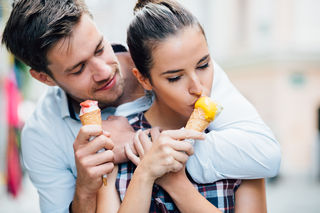Relationships
4 Ways You Can Turn a Crush Into a Relationship
Research-based steps for getting closer and making your feelings mutual.
Posted May 25, 2016 Reviewed by Jessica Schrader

Summer crush season is upon us, and these four strategies can help make your interest and good feelings mutual.
1. Let her (or him) know that you might (just might) like her.
Telling a potential partner that you like them may seem bold, but this disclosure often leads to reciprocal liking: When we find out that others like us, we tend to like them in return. Mutual liking is frequently mentioned when people describe the origin of their feelings for their current partner (Riela et al., 2010) and recall their experiences of falling in love (Aron et al., 1989). However, recent research shows that the best way to inspire positive feelings might be to leave your crush feeling uncertain about how much you like her. Whitchurch et al. (2011) asked women to review the Facebook profiles of four men who had purportedly also viewed the women’s profiles. The researchers manipulated the factor of the men’s supposed liking of the women and then asked the women to rate the men in return. Women liked the men more when they thought that the men liked them (rather than disliked them), but they rated the men most favorably when the researchers told them the men either liked them the most or liked them about average. The researchers believe this uncertainty caused the women to think about those men the most, which in turn enhanced their feelings for those men. So keep your crush on his or her toes: Let her know you like her, but don't let her know just how much you do. If this strategy isn't subtle enough for you, enlist a friend to deliver the message. After hearing that you might like her, she may not be able to stop thinking about you.
2. Get in close physical proximity.
Although many of our social interactions take place in the digital world, closeness in physical proximity in the “real” world remains a strong influence on our attraction to others. The mere act of sitting closer to a potential mate may be enough to increase how much you like that individual (Back et al., 2008). As a college professor, I frequently observe friendships and romantic relationships begin among my students. When I taught my first Attraction class, a relationship developed between two students who sat next to one another in class. Not only did they sit next to one another all semester, they sat closer to one another than my other students did. They may have chosen to sit closer to one another because they liked one another--or their liking for one another may have increased because they sat closer to one another. Research indicates that even when people are randomly assigned to sit closer to another individual, they report liking that person more (Back et al., 2008; Slane and Leak, 1978). When we are in close physical proximity to other people, we become more familiar with them, and this familiarity often leads to liking (Reis et al., 2011). So go ahead and sidle up to your crush; the physical closeness may just increase his or her feelings for you.
3. Hold eye contact.
Sustained eye contact can be an indicator of mutual liking, but even eye contact among strangers can ignite feelings of liking and loving (Kellerman et al., 1989). The direct gaze of an attractive companion increases activity in the area of the brain associated with reward (Kampe et al., 2001). In particular, women seem to use eye contact as a subtle signal of interest in a partner (Moore, 2010). For example, as I related in a previous post, my friends Suzie and Jake* met at a bar. Upon arriving, Suzie scanned the bar and immediately made eye contact with Jake. She smiled and then looked away. Soon afterward they made eye contact again, but this time they sustained their eye contact. Suzie would later describe this as “meaningful eye contact.” After a few more flirtatious glances, Jake approached Suzie and asked her to dance. The two ended up dancing together all night, kissing in the parking lot, and having lunch together the next day. Don’t be afraid to meet your crush’s eyes and hold his or her gaze; it may enhance the person's feelings for you.
4. Attend an exciting event together.
Go rock climbing, visit an amusement park, see a scary movie, or stop by the gym where your crush works out. Any activity that increases physiological arousal can also increase attraction (e.g. Dutton & Aron, 1974; Ma-Kellams et al., 2012; Meston and Frohlich, 2003; White et al., 1981). When we are physiologically aroused--specifically, when our heart beats faster and our respiration rate increases--sometimes we mistakenly attribute some of that arousal to an attractive person, which can make us view that person as even more attractive. In one classic study, Dutton and Aron asked an attractive female research assistant to stop men as they crossed two bridges to ask them to participate in research. One bridge was very high above the ground, very unstable, and very exciting to cross. The other bridge was much lower and much more stable, so it elicited much less physiological arousal. The research assistant gave each of the men she spoke with her phone number in case they wanted to know more about the research. Men who crossed the higher bridge were more likely to call her, presumably because they found the research assistant more attractive due to the increased physiological arousal associated with crossing the high bridge. So make plans to proceed to an exciting venue, and your crush may find you even more attractive.
*All names have been changed.
Each of these strategies can inspire liking, regardless of the gender of your crush. To learn more strategies that enhance attraction, check out our book, The Social Psychology of Attraction and Romantic Relationships.
Portions of this post were taken from The Social Psychology of Attraction and Romantic Relationships. Copyright 2015 Madeleine A. Fugère.
Follow me on Twitter @SocPscAttrRel and never miss a post.
References
Aron, A., Dutton, D. G., Aron, E. N., & Iverson, A. (1989). Experiences of falling in love. Journal of Social and Personal Relationships, 6(3), 243–257. doi:10.1177/0265407589063001
Back, M. D., Schmukle, S. C., & Egloff, B. (2008). Becoming friends by chance. Psychological Science, 19(5), 439–440. doi:10.1111/j.1467-9280.2008.02106.x
Dutton, D., & Aron, A. (1974). Some evidence for heightened sexual attraction under conditions of high anxiety. Journal of Personality and Social Psychology, 30(4), 510–517. doi:10.1037/h0037031
Kampe, K. W., Frith, C. D., Dolan, R. J., & Frith, U. (2001). Reward value of attractiveness and gaze. Nature, 413(6856), 589.
Kellerman, J., Lewis, J., & Laird, J. D. (1989). Looking and loving: The effects of mutual gaze on feelings of romantic love. Journal of Research in Personality, 23(2), 145–161. doi: 10.1016/0092-6566(89)90020-2
Ma-Kellams, C., Blascovich, J., & McCall, C. (2012). Culture and the body: East–West differences in visceral perception. Journal of Personality and Social Psychology, 102(4), 718–728. doi: 10.1037/a0027010
Meston, C., & Frohlich, P. (2003). Love at first fright: Partner salience moderates roller-coaster-induced excitation transfer. Archives of Sexual Behavior, 32(6), 537–544. doi: 10.1023/A:1026037527455.
Moore, M. M. (2010). Human nonverbal courtship behavior—A brief historical review. The Journal of Sex Research, 47, 171-180. doi: 10.1080/00224490903402520 http://www.tandfonline.com/doi/full/10.1080/00224490903402520
Reis, H. T., Maniaci, M. R., Caprariello, P. A., Eastwick, P. W., & Finkel, E. J. (2011). Familiarity does indeed promote attraction in live interaction. Journal of Personality and Social Psychology, 101(3), 557–570. doi: 10.1037/a0022885
Riela, S., Rodriguez, G., Aron, A., Xu, X., & Acevedo, B. P. (2010). Experiences of falling in love: Investigating culture, ethnicity, gender, and speed. Journal of Social and Personal Relationships, 27(4), 473–493. doi: 10.1177/0265407510363508
Slane, S., & Leak, G. (1978). Effects of self-perceived nonverbal immediacy behaviors on interpersonal attraction. Journal of Psychology: Interdisciplinary and Applied, 98(2), 241–248. Retrieved from PsycINFO database.
Whitchurch, E. R., Wilson, T. D., & Gilbert, D. T. (2011). “He loves me, he loves me not . . .”: Uncertainty can increase romantic attraction. Psychological Science, 22(2), 172–175. doi:10.1177/0956797610393745
White, G., Fishbein, S., & Rutsein, J. (1981). Passionate love and the misattribution of arousal. Journal of Personality and Social Psychology, 41(1), 56–62. doi: 10.1037/0022-3514.41.1.56


